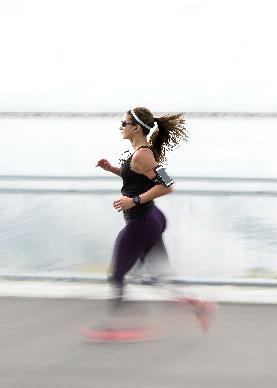Does Cycling Fitness Transfer To Running?
The amount of crossover from distance runners to cyclists is staggering. We have all heard about that person in your club that came over to cycling from distance running because they heard “they wouldn’t get injured as much” and in as little as a month they’re at the top of the peloton. Not only that, they’re only getting stronger. Does cycling fitness transfer to running?
Cycling transfers to running in most cases, though it is important to understand where and how. In this post we’ll discuss how cycling transfers to running, while also detailing the most important concerns for an athlete to make sure that the transition is as smooth as possible.


Invest in your knowledge:
These pieces of reading may be interesting to you:
- Everything you need to know about cycling and lactic acid
- Does Cycling Count as Steps?
- Does Cycling Help Running Endurance?
How Does Cycling Fitness Transfer To Running?
Cycling fitness transfers to running in all zones at and below your aerobic threshold. As you move up into more intense anaerobic zones, the differences found between the two tend to get far more divergent.
The reason being is that when you are running at your VO2 max, you are using far more fast twitch muscle than you are using when you are cycling. Not only that, far more lesser muscles are incorporated and trained when sprinting that aid in balance, agility and overall body structure strength. If you are interested in learning about lactic acid and training the upper regions of the anaerobic threshold, follow our guide here.
When running and sprinting, outside of training your aerobic capacity, your body also builds itself to be able to maintain the impact that it is going through in the ankles, knees, hips, lower and upper back. There is no need for this when cycling at aerobic pace as there are no sudden changes in direction of the body, nor is there any impact.


You are also teaching your body to engage your core while cycling and working similar muscles which transfers well to running, keeping your balance during long rides, and maintaining a healthy posture.
When you train in the aerobic zones, this becomes far less of a factor as you do not have the same level of impact on the bones and body. You still have substantially more than cycling, though it is nowhere near the impact level that is sprinting. Therefore this is a concern for the avid athlete looking to be transitioning between the two sports.
Is it easy to transition as an endurance runner to endurance cycling?
The majority of endurance runners that transition to cycling find that they have a very easy time with the transition. The reason being is that when running, the body is training it’s aerobic capacity and impact tolerance.
When transitioning to cycling there is no need for the body to consider impact tolerance anymore, and the focus becomes aerobic capacity. Therefore you’ll tend to find that top cyclists tend to have a higher aerobic capacity than top runners.
The difference being that the top cyclist will not have the ability to run at the same rate as a top runner as their bodies are not built to sustain the level of impact or stave off injury.
Of course, if they do and train ignoring these limitations that running imposes, the possibility of injury are very high.
Is it easy to transition as an endurance cyclist to endurance running?
This is a transition that many people make and they are surprised by (although very possible) how difficult it be. Even if they ran proficiently earlier in their lives.
This transition is do-able because you have the aerobic capacity to become a proficient endurance runner. The difference being, and why it may be more of a challenge is that the avid cyclist may need to train below their aerobic level of fitness to prepare the body for the level of impact that it will take when running.
For example, a cyclist that trains 100 miles+ a week will find their bodies feeling beat up and sluggish after transitioning and training 35+ miles of running a week.


This can be a concern for some, though it can be learned by the body and by the athlete over time. This just means that the transition into running would be marginally more difficult, than transitioning to cycling but still all too possible.
How many hours of cycling is equal to running?
1:3 is the typical ratio that you will see and this is mostly correct. In general terms, converting cycling time to running time is easier than cycling distance to running distance.
The difference and main concern is that when you factor in hill work, cycling speed, and wind resistance, the ability to make the conversion makes it far more difficult.
Our advice is to begin with the ratio and then once you get a true feel of how long typical rides take on the bike, you will be able to understand how you felt when running a certain distance and make the conversion that way.
Is Running Harder Than Cycling?
Cycling overall creates a stronger aerobic system than running though falls short at building the body up (and down due to overtraining) like running is able to do.
- Running is harder on the body than cycling.
- Cycling is harder on the aerobic system than running.
You will also find that when running the body requests more oxygen for a lower conversion into energy in comparison to cycling.
Should I Run More or Cycle More?
This all depends on your goals. For example, I have competed in enough competitive running events for a lifetime. My goals now are to be able to train my endurance strength throughout the rest of my life.
Therefore, I have shifted my focus to cycling more so that the impact from running does not keep me from achieving my goals.
If your goals have to do with more running focused achievements such as a marathon, or a 5K, then you should run more. All of this depends on how you would like to develop your body.
Can I do both running and cycling?
Yes, it is highly recommended to do both running and cycling. If you have the time, cross-training is one of the most beneficial ways to create a well rounded athlete. Mixing different training routines together will help you learn from different mindsets, and your body will be able to pick up different aspects of the training in a more formulaic way.
Try also grouping other types of training together if you have the time such as yoga (vinyasa, hatha, or yin [for recovery]), swimming, running, and biking. You will be happy with the results, and also be pleased to be a well rounded athlete.
What is Healthier Running or Cycling?
Both are excellent means to be able to lose weight, increase your heart health and maintain a healthy mental state. Both of the activities are extremely healthy as long as they are done consistently over a long period of time.


You will receive major health benefits from simply running for half an hour every other day for a year. The same can be said for cycling. (however, the most healthy thing is to eat correct before running or cycling).
Do you lose more belly fat cycling or running?
If my goal were to solely lose belly fat, I would choose to cycle over running. Why is this? Because with cycling, you can train as long as you want, when you want, with effectively zero possibility of an overuse injury.
With running, you are able to burn the same amount of calories over time, however you are putting yourself at risk to other possibilities like tendinitis, shin splints, hamstring pulls and more. With cycling, there is minimal risk to these injuries because the sport is low impact.
Both cycling and running are great exercises to decrease belly fat because they are both aerobic exercises which is specifically done to decrease overall body weight, and train the heart. Our recommendation is to try both to see what works with your body.
Many cyclists and runners have done both sports in their lives, and cross train throughout the season. There is much overlap that the body can be gained from by doing both sports that athletes tend to enjoy both when they are able.
Does cycling keep you as fit as running?
Both cycling and running are aerobic exercises. This means that they train very similar aspects of the body: namely, the hearts ability to transfer energy to the rest of the body. Outside of this, there are very few differences between the way that running and cycling will train the body, except one.
When you are cycling, you are more efficiently training the system that will help you decrease body fat, tone your body, and strengthen the heart.
When you are running, you are training the overall structure of the body to strengthen. This means your bones, the ligaments, tendons, joints and all other tissues in between to develop themselves to stave off overuse injury.
So does cycling keep you as fit as running? If your specific goal is to remain in cardio-vascular shape, then yes, cycling will keep you more fit than running.
However, if you transition to riding completely, you will notice that when you move back into distance running, you will feel many small aches and pains, as the body is not used to the impact from running as often.
What is The Equivalent to “Running The 5K” For Cycling?
Simply put, the races and distances are different between the two sports. Though to answer the question based off of the view of accomplishment and level of training required, the 50 mile would most likely be the closest conversion. The century (100 mile) race event are also available to cyclists and are considered the flagship endurance event of American cyclists most closely associated with running a marathon.


Conclusion
Does Cycling Fitness Transfer To Running? Cycling and Running have many similarities though some stark contrasts.
Cyclists that are looking to get into running should ask themselves several questions about the goals that they are looking to achieve, along with understanding how the change in sport will affect their body.
One is not equivalent to the other, though experience in one will lead to an excellent transition to the other. Does Cycling fitness transfer to running? Yes.







![Can Cycling Replace Leg Day? [Muscle Building Guide]](https://routeonecycling.com/wp-content/uploads/2023/05/Can-Cycling-Replace-Leg-Day1.png)